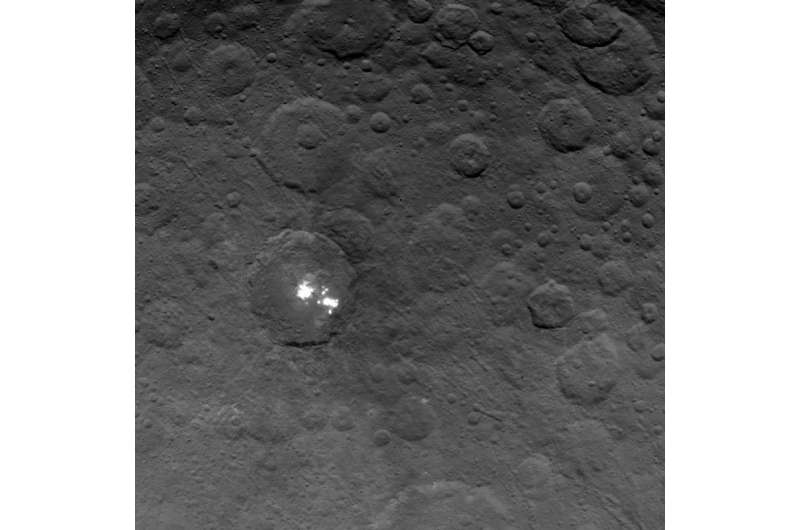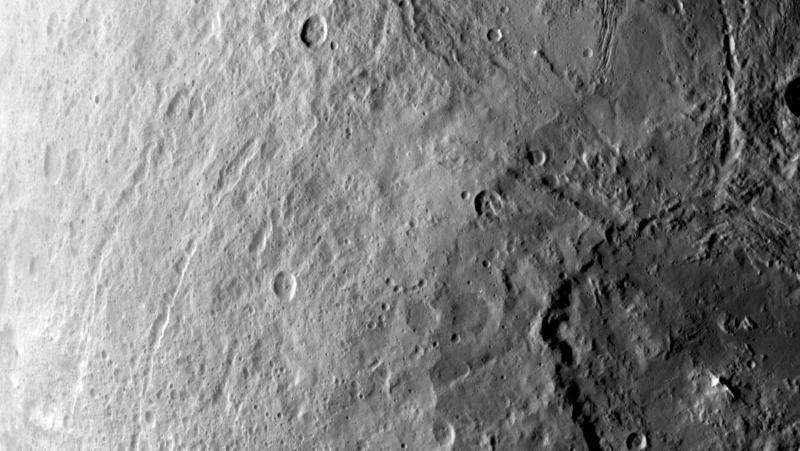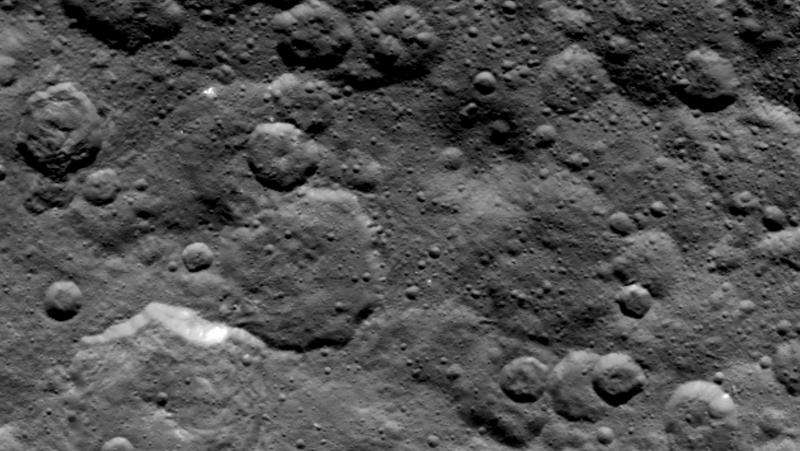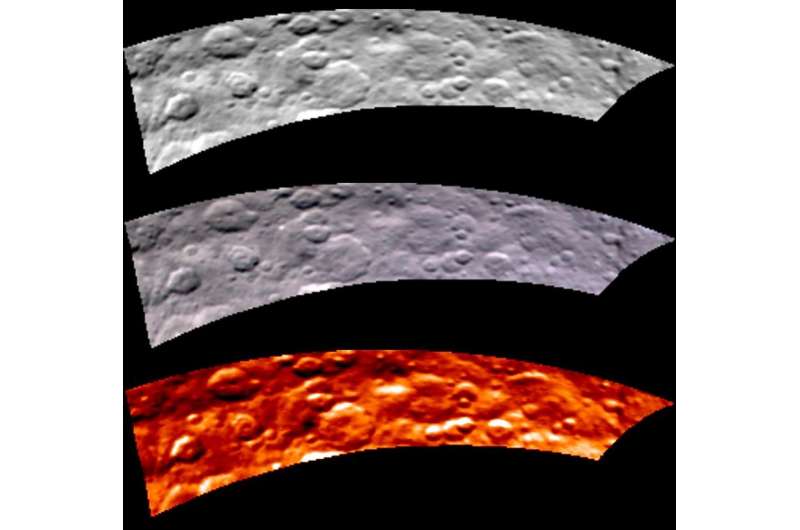The brightest spots on dwarf planet Ceres are seen in this image taken by NASA's Dawn spacecraft on June 6, 2015. This is among the first snapshots from Dawn's second mapping orbit, which is 2,700 miles (4,400 kilometers) in altitude. The resolution is 1,400 feet (410 meters) per pixel. Scientists are still puzzled by the nature of these spots, and are considering explanations that include salt and ice. Credit: NASA/JPL-Caltech/UCLA/MPS/DLR/IDA
New images of dwarf planet Ceres, taken by NASA's Dawn spacecraft, show the cratered surface of this mysterious world in sharper detail than ever before. These are among the first snapshots from Dawn's second mapping orbit, which is 2,700 miles (4,400 kilometers) above Ceres.
The region with the brightest spots is in a crater about 55 miles (90 kilometers) across. The spots consist of many individual bright points of differing sizes, with a central cluster. So far, scientists have found no obvious explanation for their observed locations or brightness levels.
"The bright spots in this configuration make Ceres unique from anything we've seen before in the solar system. The science team is working to understand their source. Reflection from ice is the leading candidate in my mind, but the team continues to consider alternate possibilities, such as salt. With closer views from the new orbit and multiple view angles, we soon will be better able to determine the nature of this enigmatic phenomenon," said Chris Russell, principal investigator for the Dawn mission based at the University of California, Los Angeles.
Numerous other features on Ceres intrigue scientists as they contrast this world with others, including protoplanet Vesta, which Dawn visited for 14 months in 2011 and 2012. Craters abound on both bodies, but Ceres appears to have had more activity on its surface, with evidence of flows, landslides and collapsed structures.
Additionally, new images from Dawn's visible and infrared mapping spectrometer (VIR) show a portion of Ceres' cratered northern hemisphere, taken on May 16, including a true-color view and a temperature image. The temperature image is derived from data in the infrared light range. This instrument is also important in determining the nature of the bright spots.
Having arrived in its current orbit on June 3, Dawn will observe the dwarf planet from 2,700 miles (4,400 kilometers) above its surface until June 28. In orbits of about three days each, the spacecraft will conduct intensive observations of Ceres. It will then move toward its next orbit of altitude 900 miles (1,450 kilometers), arriving in early August.
A large crater in the southern hemisphere of dwarf planet Ceres is seen in this image taken by NASA's Dawn spacecraft on June 6, 2015. This image shows many different surface structures associated with impacts. This is among the first snapshots from Dawn's second mapping orbit, which is 2,700 miles (4,400 kilometers) in altitude. The resolution is 1,400 feet (410 meters) per pixel. Credit: NASA/JPL-Caltech/UCLA/MPS/DLR/IDA
On March 6, 2015, Dawn made history as the first mission to visit a dwarf planet, and the first to orbit two distinct extraterrestrial targets. At its previous target, Vesta, Dawn took tens of thousands of images and made many observations about the body's composition and other properties.
-
Craters in the northern hemisphere of dwarf planet Ceres are seen in this image taken by NASA's Dawn spacecraft on June 6, 2015. This is among the first snapshots from Dawn's second mapping orbit, which is 2,700 miles (4,400 kilometers) in altitude. The resolution is 1,400 feet (410 meters) per pixel. Credit: NASA/JPL-Caltech/UCLA/MPS/DLR/IDA
-
Images from Dawn's visible and infrared mapping spectrometer (VIR) show a portion of Ceres' cratered northern hemisphere, taken on May 16, 2015. From top to bottom, the views include a black-and-white image, a true-color view and a temperature image. The true-color view contains reddish dots that are image artifacts, which are not part of Ceres' surface. These images were taken at a distance of 4,500 miles (7,300 kilometers) from Ceres. They have a resolution of 1.1 miles (1.8 kilometers) per pixel. The temperature image is derived from data in the infrared light range. The lightest areas are the hottest and the darkest are the coolest. Credit: NASA/JPL-Caltech/UCLA/ASI/INAF
More information: More information about Dawn is available at dawn.jpl.nasa.gov
Provided by Jet Propulsion Laboratory



























